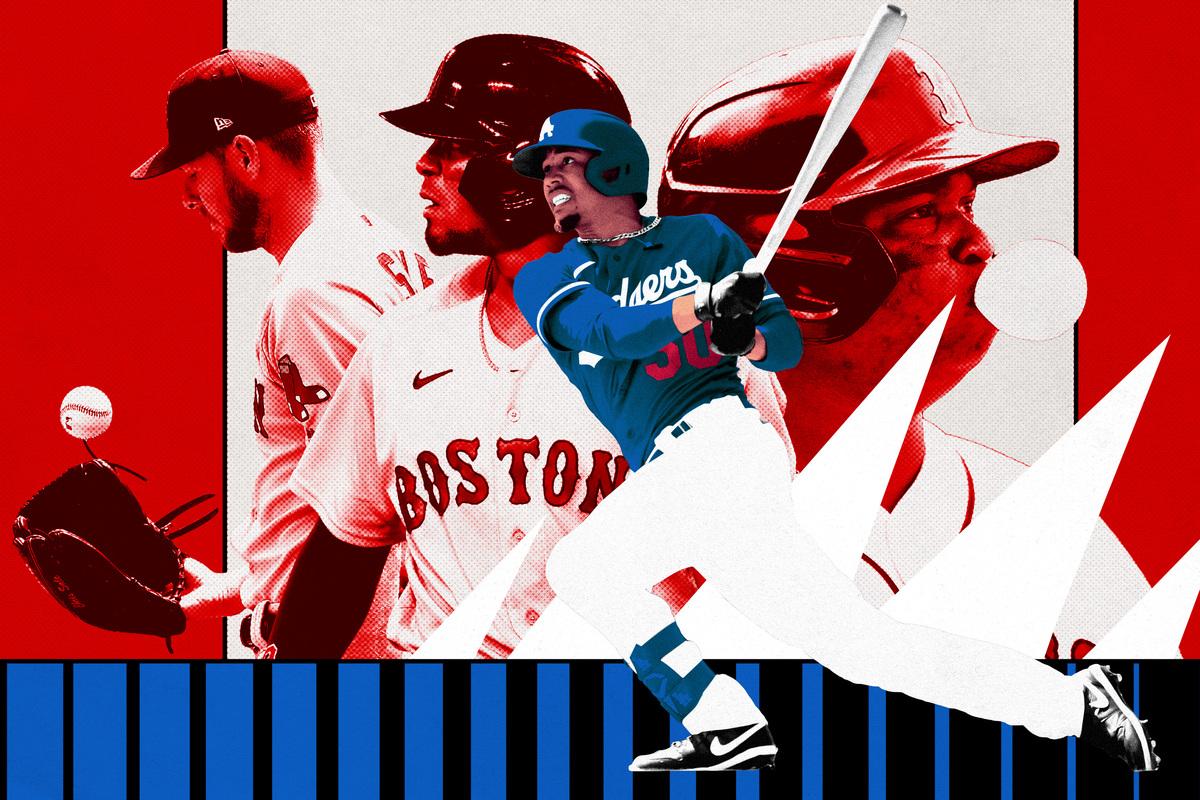
Just 22 months ago, the Red Sox hoisted the World Series trophy in Los Angeles, capping off an 11-3 playoff run and a 108-win regular season. On Wednesday, they sit at 10-20, 9.5 games out of first place in the AL East, staring down the barrel of a lost season.
The drop has been breathtaking—from 108 wins to 84 last year, to their current pace, which would work out to 54 wins over the course of a 162-game season. Boston’s playoff odds have plummeted from 64.7 percent at the start of the season, per FanGraphs, to 7.6 percent today, behind the Orioles, Royals, and Tigers, all teams expected to be among the American League’s worst but who currently boast better records than the Sox. The 10-20 record through 30 games is the franchise’s worst since 1996. Any attempt to explain the Red Sox’s precipitous fall must navigate the Mookie Betts trade, a stingy offseason, a sign-stealing scandal, a historically unique season due to the COVID-19 pandemic, and injuries, but nothing better encapsulates why the team’s Baseball-Reference page currently looks like a CVS receipt of L’s than one number: 6.07 runs allowed per game, worst in all of baseball.
Conversely, the 2018 team that won the World Series was tied for second in the AL in that same statistic. Chris Sale struck out 13.5 batters per nine innings and amassed 6.9 bWAR; now, after a confounding and injury-shortened 2019 season, he’s out after undergoing Tommy John surgery in March. That championship season, David Price added 4.2 WAR, Rick Porcello 3.0, budding star Eduardo Rodríguez 2.9, and closer Craig Kimbrel 2.3; Price was traded with Betts to the Dodgers, Porcello signed with the Mets in free agency, Rodríguez is out for the year due to complications from COVID-19, and Kimbrel now pitches for the Cubs. Boston’s most noteworthy addition to the pitching staff this offseason was longtime Astro Collin McHugh, who excelled last year out of Houston’s pen but opted out of this season to focus on his recovery from an offseason elbow procedure.
That’s how the team has ended up with a starting rotation led by Nathan Eovaldi and Martín Pérez, with contributions from Zack Godley, Ryan Weber, and other subpar options. The bullpen, which was anchored by Brandon Workman until he was traded to Philadelphia this week, has posted a 5.59 ERA, which is second worst in all of baseball (behind the Phillies) and still better than their starters’ mark. This year’s Red Sox staff bears almost no resemblance to 2018’s championship outfit, in both name and production.
But while pitching is by far the team’s biggest issue, that doesn’t absolve the offense for its role in the team’s performance. From 2018 to 2019, Boston maintained an elite offense, finishing tops in MLB in runs scored during their championship season and fourth last year. This year, the individual dips that led to that small decline have blossomed into full-blown Struggles. Xander Bogaerts, Alex Verdugo, Kevin Pillar, and Mitch Moreland (seven HRs in 56 ABs!) have produced, but not enough to overcome tepid starts from J.D. Martinez, Jackie Bradley Jr., Rafael Devers, and Andrew Benintendi, the latter of whom is bringing up the rear with a 43 wRC+ and minus-0.5 WAR. Only the Rangers have a worse run differential than the Red Sox, and only the Pirates and Angels have won fewer of their games. That’s not the kind of company Boston wants to keep.
In addition to these slumps, there’s another noteworthy change to this year’s offense, and he’s currently lapping up sunshine and dingers in L.A. Last offseason, the Red Sox came to a fork in the road and (indefensibly) chose to trade Mookie Betts to avoid incurring the luxury tax, or, as they put it, to achieve payroll flexibility. Betts, who is currently slashing .293/.359/.638 and building a strong case for NL MVP, would undoubtedly improve the Red Sox. But the team can only look forward, and despite its current place in the standings, the future isn’t entirely bleak. Boston now finds itself facing another, arguably more urgent and consequential, fork. Will they continue their pursuit of sustained long-term success, the reasoning that led to the Betts trade, or will they reinvest in their current team and try to return to contention, which actually isn’t that far off?
As bad as this year has been, Boston could return to playoff contention next year. A 10-20 record is a hell of a warning sign, but it’s also not a true representation of the talent on the team. Coincidentally, Tuesday night’s 9-7 victory over Toronto provides a more accurate snapshot of the Red Sox: They got an offensive explosion (six runs in the sixth) to overcome a 3 1/3 inning, six-run start from [checks notes] Kyle Hart. Even without Mookie, the Red Sox’s offensive core still belongs near the top of the league, assuming they don’t move anyone else before the trade deadline. Early ZiPS projections for 2021 expect Bogaerts and Devers to top 4.0 fWAR and peg Martinez, Benintendi, Christian Vázquez, and Verdugo as solid contributors. Getting Sale and Rodríguez back should significantly elevate the rotation, though neither is a sure thing; Sale will be returning from Tommy John a year after his worst season as a starter, and Rodríguez will (hopefully) be returning from COVID-19 and resulting myocarditis, a heart condition whose long-term effects are still unknown.
The Red Sox have the bones of a strong team, but they also have holes. Even if Sale and Rodríguez do return at full strength, the pitching staff is weak behind them. Additionally, FanGraphs ranks their farm system 29th out of 30, so it’s not as if internal help is on the way. Without more attractive prospects, it will be hard for the Red Sox to make meaningful improvements in the trade market, but reinforcements in free agency could vault Boston at least toward the middle of the pack in the AL. But the front office would need to make a concerted choice to sign them.
Though the Betts trade can hardly account for the scale of the present on-field disaster, the team’s flimsy explanation and the fact that the front office let such a rapid dissolution of the pitching staff occur in the first place casts doubt on a return to the playoffs. In theory, Boston could use the money it didn’t spend on Betts to plug holes in the roster and bolster the rest of the team. Trevor Bauer, Robbie Ray, James Paxton, José Quintana, and Marcus Stroman will be free agents after this season. Same for a handful of back-end bullpen arms like Ken Giles and Dellin Betances. They aren’t perfect options but they all should post ERAs under 5.92. A few additions along with Sale and Rodríguez, plus Bogaerts, Devers, Martinez, and Verdugo, and the 2021 Sox could have the makings of a formidable team.
That’s the whole point of “financial flexibility” after all, and it’s supposedly the reason the Red Sox went through so much trouble to dip under the luxury tax, which will officially reset if the MLB season extends into September. Except financial flexibility is typically a lie, as Rob Arthur wrote for Baseball Prospectus after the Betts trade. Arthur’s research shows that teams that trim their budgets don’t usually spend more later, and that’s before factoring in the effects of COVID-19, which many expect to further suppress spending in free agency. Sure, the Red Sox could buck that trend, but last offseason’s inactivity despite glaring holes in the roster suggests they won’t.
More likely, they’ll wade into the sellers’ market, with the August 31 trade deadline fast approaching. ESPN’s Jeff Passan classifies the Red Sox as “definite sellers,” and writes that they should shop everyone besides Bogaerts, Devers, and Verdugo. Others are openly wondering whether the team should explore the market for Bogaerts, too. (GM Chaim Bloom, for what it’s worth, said that a Bogaerts trade was not “something we’re trying to do by any stretch.”) Trading any of these players would represent another, more deliberate step down the path Boston started to take last offseason.
Just because Mookie is gone doesn’t mean the Red Sox need to punt on trying to make the playoffs, and soon. They aren’t as far from contention as their neighbors in the standings, but they have reached another fork in the road and they’ll need to make a choice. Whether this debacle of a season will be a blip on the way back to contention or a springboard for a longer, more drawn out rebuild remains to be seen.
For now, the Red Sox will keep taking the field. At 10-20, there’s little hope for salvaging this season, but fans may take solace in one notable area of improvement. On average, this year’s Red Sox games are four minutes shorter than last year’s. It’ll be over before you know it.

